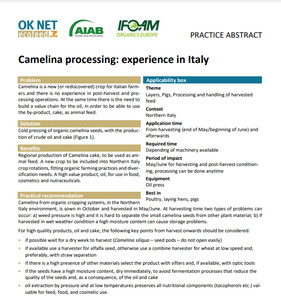{Tool} Camelina processing: experience in Italy (OK-Net EcoFeed Practice abstract). Creator(s): Micheloni, Cristina. Issuing Organisation(s): AIAB - Associazione Italiana Agricoltura Biologica. OK-Net Ecofeed Practice abstract. (2021)
|
PDF
- Published Version
- English
(Camelina processing: experience in Italy)
264kB | |
![[thumbnail of 2022-06-17 13_31_52-Camelina processing_ experience in Italy.png]](/39648/3.hassmallThumbnailVersion/2022-06-17%2013_31_52-Camelina%20processing_%20experience%20in%20Italy.png)  Preview |
Image (PNG)
- Cover Image
- English
89kB |
|
PDF
- Published Version
- Italian/Italiano
589kB |
Summary in the original language of the document
Regional production of Camelina cake, to be used as animal feed. A new crop to be included into Northern Italy crop rotations, fitting organic farming practices and diversification needs. A high value product, oil, for use in food, cosmetics and nutraceuticals.
Camelina from organic cropping systems, in the Northern Italy environment, is sown in October and harvested in May/June. At harvesting time two types of problems can occur: a) weed pressure is high and it is hard to separate the small camelina seeds from other plant material; b) if harvested in wet weather condition a high moisture content can cause storage problems.
For high quality products, oil and cake, the following key points from harvest onwards should be considered:
• if possible wait for a dry week to harvest (Camelina siliqua – seed pods – do not open easily)
• if available use a harvester for alfalfa seed, otherwise use a combine harvester for wheat at low speed and, preferably, with straw separation
• if there is a high presence of other materials select the product with sifters and, if available, with optic tools
• if the seeds have a high moisture content, dry immediately, to avoid fermentation processes that reduce the quality of the seeds and, as a consequence, of the oil and cake
• oil extraction by pressure and at low temperatures preserves all nutritional components (tocopherols etc.) valuable for feed, food, and cosmetic use.
| EPrint Type: | Practice tool |
|---|---|
| What problem does the tool address?: | Camelina is a new (or rediscovered) crop for Italian farmers and there is no experience in post-harvest and processing operations. At the same time there is the need to build a value chain for the oil, in order to be able to use the by-product, cake, as animal feed. |
| What solution does the tool offer?: | Cold pressing of organic camelina seeds, with the produc-tion of crude oil and cake (Figure 1). |
| Country: | Italy |
| Type of Practice Tool: | Practice abstracts |
| Keywords: | Camelina, feeding, processing, feed processing, layers, pigs, harvested feed |
| Agrovoc keywords: | Language Value URI English Camelina http://aims.fao.org/aos/agrovoc/c_33634 English feeding http://aims.fao.org/aos/agrovoc/c_2838 English processing http://aims.fao.org/aos/agrovoc/c_6195 |
| Subjects: | Animal husbandry > Feeding and growth Food systems > Processing, packaging and transportation Animal husbandry > Production systems > Pigs Animal husbandry > Production systems > Poultry Crop husbandry > Post harvest management and techniques |
| Research affiliation: | European Union > Horizon 2020 > OK-Net EcoFeed European Union > Horizon 2020 > OK-Net EcoFeed > OK-Net Ecofeed Tools Italy > AIAB European Union > Organic Farm Knowledge |
| Horizon Europe or H2020 Grant Agreement Number: | 773911 |
| Related Links: | https://organic-farmknowledge.org/tool/39648, https://aiab.it/, https://www.facebook.com/organicfarmknowledge/posts/237926894786619, https://twitter.com/farm_knowledge/status/1384115218830139392 |
| Project ID: | ofk |
| Deposited By: | Forschungsinstitut für biologischen Landbau, FiBL |
| ID Code: | 39648 |
| Deposited On: | 31 Mar 2021 10:28 |
| Last Modified: | 02 May 2024 10:32 |
| Document Language: | English |
| Status: | Published |
Repository Staff Only: item control page

 Download Statistics
Download Statistics Download Statistics
Download Statistics
